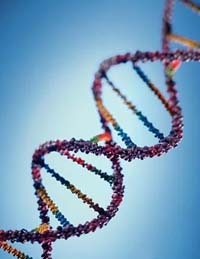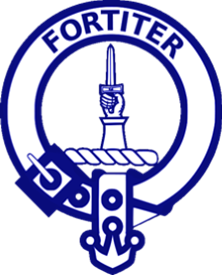DNA Testing: Linking Past, Present, and Future
by Cynthia McAlister Bresson
In early November 2005 I attended the International Conference on Genetic Genealogy in Washington D.C. Wanda Shelton, CMA genealogy committee chairman, was unable to attend, and I was pleased to represent Wanda and the CMA. Using s DNA tests to advance family research has long been an interest of mine, dating back to a conference several years ago where Dr. Brian Sykes of Oxford University Ancestors was a speaker. The Washington program was co-sponsored by the National Geographic Society and Family Tree DNA (FTDNA) of Houston, Texas. FTDNA was an early entrant into using DNA tests for genealogy purposes and is the company associated with the McAlister family DNA project. The November agenda featured a who's who of genetic genealogy.

Speakers included co-founders of FTDNA Bennett Greenspan and Max Blankfeld; population geneticist and expert on population genetics and statistical applications in genetics Bruce Walsh, PhD; biotechnology research scientist at the University of ArizonaS Michael Hammer, PhD; Doron Behar, MD, PhD, a population geneticist working in Israel; and several others. Both the content and the possibilities for future applications were fascinating. I will try here to explain some of the information acquired at that meeting.

Human genomes (genetic patterns) are 99.9% identical; we all are far more similar than diverse. But that tiny .1% difference holds clues to our ancestries, the roots of all human migration, and even our propensity for disease. Six years ago the term "genetic genealogy" did not even exist, according to Bennett Greenspan of FTDNA. A recent PBS series interviewed several high-profile black Americans including Whoopi Goldberg and Quincy Jones. They discussed their own DNA tests and what was learned from the results.
As individuals track down their personal family narratives, population geneticists are seeking the larger story of humankind. IBM, National Geographic Society and FTDNA are jointly conducting a large project that plans to collect 100,000 DNA samples from indigenous populations over the next five years. Those results will be used to trace human history and migration possibly back to the beginning of our species. Exciting discoveries include a most recent common ancestor (MRCA)--a genetic "Adam & Eve" being traced back to Africa. Recently a group of scientists have found that 40% of the world's Ashkenazi Jews descend from just one woman; another group has found that one in five males in northwest Ireland may be descended from a 5th century warlord.

Several years ago Wanda Shelton set up a McAlister family project with the FamilyTree DNA company. A CMA member who has a DNA test is compared to every other member of our group. The several US companies offering this service are currently working on a plan to have the option of checking for matches in every company's database. For CMA purposes, all of our membership will most likely belong to that Western Europe haplogroup. We use DNA testing to identify a MRCA (most recent common ancestor) for various families. An example of this is the exact match of Frank McAlister and the late Bob McAllister, both of Arlington, VA, and Steve McCallister of IN. (Note the spelling variation.) While Frank and Bob have known they were both descended from the J26 James McAlister ancestral line, Steve was a surprise. One possible explanation was that Steve descended from a brother or son of J26 who went west and lost contact with the family remaining in North Carolina. More research is needed before there is a definitive answer to how the three are related; currently the only certainty is that they are descended from a common male ancestor.
Another interesting CMA match has been the recent test results from J27 John McAlister and A01 Angus McAllister descendents. Several early historians writing in the 1800’s referred to these two as "near kin" but gave no details. Researchers have long suspected the two were related, but no primary evidence has been found to prove that link. DNA test results provide new motivation to find the connection. DNA testing is still in its infancy and at this time can only give us probabilities of family connections. According to conference speakers, the day will come when DNA science will be able to tell us if two individuals were father and son, or brothers, or cousins. In 1998, extensive media coverage was devoted to Thomas Jefferson and possible descendents with a slave, Sally Hemings. While DNA did confirm some of the Hemings were of the Jefferson family, the tests could not determine if the paternal ancestor was Thomas Jefferson or another Jefferson male.
FamilyTreeDNA and other companies in the business of DNA tests offer several levels of complexity. This is commonly stated as the number of markers to be tested. Markers refer to the location of sequences tested; the more sequences compared between people, the better odds for accurate matches. Matches for 25 of 25 markers show a higher probability of a mutual common ancestor than matches for 12 of 12. Here is a brief chart to illustrate the differences:
| Match 12 of 12 markers, the probability that two people share a common ancestor within the last. . . | ||||
|---|---|---|---|---|
| 4 generations | 8 generations | 12 generations | 16 generations | 20 generations |
| 33.57% | 55.88% | 70.69% | 80.53% | 91.41% |
| Match 25 of 25 markers, the probability that two people share a common ancestor within the last. . . | ||||
|---|---|---|---|---|
| 4 generations | 8 generations | 12 generations | 16 generations | 20 generations |
| 61.17% | 84.92% | 94.15% | 97.73% | 99.12% |
| Match 37 of 37 markers, the probability that two people share a common ancestor within the last. . . | ||||
|---|---|---|---|---|
| 4 generations | 8 generations | 12 generations | 16 generations | 20 generations |
| 83.49% | 97.28% | 99.55% | 97.93% | 99.99% |
FTDNA offers choice of tests, including a 12-marker, 25-marker, 37-marker, and recently added a 59-marker. Because we have a McAlister family project registered with FTDNA, our members receive a discount price for DNA tests. CMA members can have a 12 marker test done for $99 ($149 usual price); 37 marker test for $189 ($259 usual) and 59 marker test for $269 ($349 usual). The 25 marker test is being discontinued due to technological advances. Tests can be upgraded anytime after the initial results. Much more information in greater detail can be found on the website for FTDNA, www.familytreedna. If you are interested in having a DNA test done, contact the CMA DNA project team at:

TheThe process is as simple as rubbing the inside of your cheek with an oversized Q-tip. If you are thinking of a DNA test, the company recommends starting with a 12 marker test. If close matches are found, the tests can then be upgraded to a higher level. FTDNA places a high priority on confidentiality and privacy for its customers. Samples are identified in the FTDNA lab only by an ID number. While FTDNA controls the surnames database, the Dr. Hammer’s lab at the University of Arizona maintains the genetic database. This is considered a double safety net, since only a strictly limited number of staff have access to both databases. FamilyTree DNA tests are used only for genealogy purposes, and not for genetically linked diseases, paternity suits, forensic proof, or any other purpose.

The future of scientific discoveries such as genetic genealogy holds great promise for those who pursue the study of their ancestors. Although current procedures may seem very advanced to us now, certainly within a finite period of time, present procedures will seem primitive indeed. I for one am curiously awaiting new developments in genetic genealogy.
References:
- Genealogy and Genetics, A Theme Issue of the NGS Quarterly,”National Genealogical Society Quarterly", Dec. 2005.
- Forrelle, Charles, "Project Hopes to Trace Your Ancestors Back 10,000 Years", Wall Street Journal, Oct. 24, 2005.
- International Conference on Genetic Genealogy, Nov 5-6, 2005, Powerpoint files
- Kalb, Claudia, "Genes & Family: What Science Can Tell You About Your History," Newsweek, Feb 8, 2006.
- Smolenyak, Megan & Davis, Ann. "Trace Your Roots with DNA: Using Genetic Tests to Explore Your Family Tree."
- Sykes, Brian. The Seven Daughters of Eve

